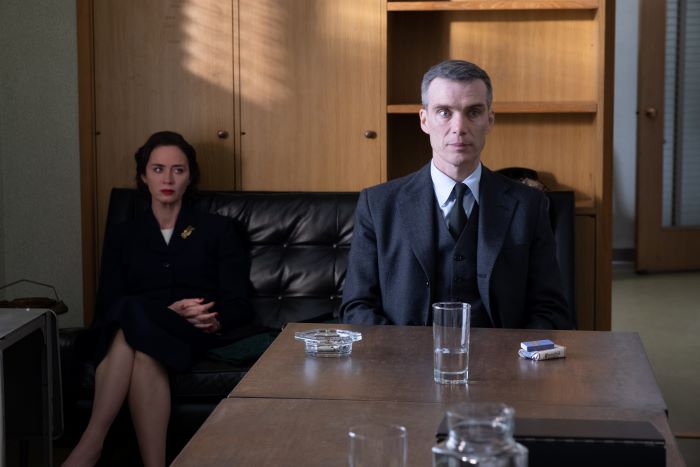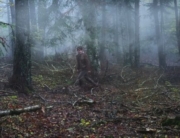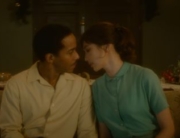![]() For filmmakers, the depiction of the art of creation poses a considerable challenge: How to get inside the mind of a creator/genius? (Remember Julia’s Jane Fonda as stymied writer Lillian Hellman at work, banging on a typewriter, slugging booze, taking a drag of a cigarette, and then in frustration, throwing the typewriter off the desk?) In his new film, screenwriter/director Christopher Nolan nimbly gets inside the feverish mind of physicist J. Robert Oppenheimer, the leader of the top-secret Manhattan Project, which produced the first atomic bomb. That’s one reason why his somber biopic departs from the usual fussiness and stateliness of the genre.
For filmmakers, the depiction of the art of creation poses a considerable challenge: How to get inside the mind of a creator/genius? (Remember Julia’s Jane Fonda as stymied writer Lillian Hellman at work, banging on a typewriter, slugging booze, taking a drag of a cigarette, and then in frustration, throwing the typewriter off the desk?) In his new film, screenwriter/director Christopher Nolan nimbly gets inside the feverish mind of physicist J. Robert Oppenheimer, the leader of the top-secret Manhattan Project, which produced the first atomic bomb. That’s one reason why his somber biopic departs from the usual fussiness and stateliness of the genre.
Viewers will not come away knowing how nuclear fusion takes place or the mechanics of quantum physics, but they will glimpse what Oppenheimer imagines in this exuberantly edited, high-stakes epic that dares viewers to look away. Flashes of images range from particles floating in the air to a starry sky warping as though it is being sucked down a drain. The propulsive pace, the varied and omnipresent soundtrack, and the strategically deployed sound design effortlessly guide viewers along the three hours running time. Nolan and his sound editors know the strategic importance of silence in what amounts to the climax, the successful testing of the atomic bomb at White Sands Proving Ground, New Mexico, on July 16, 1945.
Like the onscreen particles, there are plenty of themes floating about. The largest issue at hand is the dawn of the atomic age, which, as portrayed here, Oppenheimer, with much trepidation, brought upon the world as the leader tasked in the development of an atomic weapon. He and the U.S. government were in a race to beat Nazi Germany’s scientists from achieving a similar goal. To energize the drama, Nolan sets his sights on—as the main conflict—the betrayals that will lead to the world-renowned scientist having his security clearance revoked in 1954. The film unfolds with a young Oppenheimer studying at 1920s Cambridge and flashes forward to his contentious hearing before the security board of the Atomic Energy Commission decades later. It’s as if his time line is inevitable: The beginning is also the end.
Cillian Murphy’s depiction of Oppenheimer is a conflagration of contradictions: introspective, methodical, suavely theatrical, arrogant, an academic who may not deign to read the room. His blunt honesty and parsing of ideas may be too refined, evasive, equivocal for the times—or his fellow scientists. And naive, as when he believes that the creation of the atomic bomb may bring everlasting peace and that a future war is “unthinkable.” Murphy intriguingly underplays the multilingual Renaissance man, who is a walking and talking cipher—and the life of the party, he isn’t. It’s Matt Damon’s General Leslie Groves who brings a refreshing dash of brash, no-nonsense drollness to the secret weapon’s trial and error creation.
However, unlike his protagonist micromanaging a complicated endeavor, Nolan does not always have a tight rein on his huge ensemble. Benny Safdie, as fair-weather friend Edward Teller, the father of the hydrogen bomb, speaks with a thick German accent straight out of a 1940s B movie. Emily Blunt’s Kitty Oppenheimer is a sketch. Though incisive and straightforward, Kitty flits in and out of the story lines as the angry, embittered, alcoholic wife. And if anyone thought that Gary Oldman chewed the scenery as Winston Churchill in The Darkest Hour, wait till you see his Hee Haw impression of Harry S. Truman.
Additionally, if viewers have a tangential or bare bones knowledge of Oppenheimer, it’s safe to say that they might be clueless about Lewis Strauss (Robert Downey Jr.), a founding commissioner of the U.S. Atomic Energy Commission. Yet he emerges as one of the more important players in Oppenheimer’s fate. Here though, Strauss has been given short shrift, developed late in the game. The screenplay doesn’t provide enough explanation for the audience to fully understand his role in Oppenheimer’s career. It’s not like the screenplay doesn’t go out of its way to make its points, offering biopic bits of exposition, such as Strauss’s self-aware acknowledgement: “This is the McCarthy era.”
At its best, Oppenheimer is downright surreal, not only in the flashes of images that may not be readily deciphered, but also how Nolan merges time lines together through incisive editing that deftly depicts Oppenheimer’s pre–World War II past haunting him during the 1950s Red scare. One cannot accuse the film of biopic banality. The tone fervently fluctuates. Even an interrogation in a bare, drab cubby hole of an office startlingly takes a sensuous turn. You may know the trajectory of the scientist’s career, but what Nolan whips up on screen will be a surprise.

















Leave A Comment